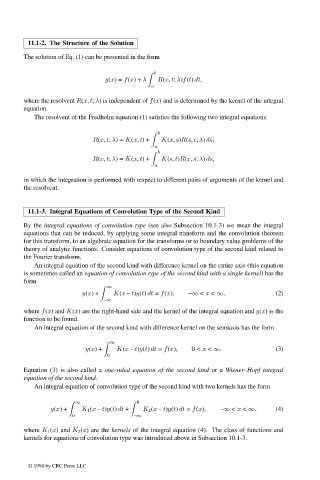Page 545 - Handbook Of Integral Equations
P. 545
11.1-2. The Structure of the Solution
The solution of Eq. (1) can be presented in the form
b
y(x)= f(x)+ λ R(x, t; λ)f(t) dt,
a
where the resolvent R(x, t; λ) is independent of f(x) and is determined by the kernel of the integral
equation.
The resolvent of the Fredholm equation (1) satisfies the following two integral equations:
b
R(x, t; λ)= K(x, t)+ K(x, s)R(s, t; λ) ds,
a
b
R(x, t; λ)= K(x, t)+ K(s, t)R(x, s; λ) ds,
a
in which the integration is performed with respect to different pairs of arguments of the kernel and
the resolvent.
11.1-3. Integral Equations of Convolution Type of the Second Kind
By the integral equations of convolution type (see also Subsection 10.1-3) we mean the integral
equations that can be reduced, by applying some integral transform and the convolution theorem
for this transform, to an algebraic equation for the transforms or to boundary value problems of the
theory of analytic functions. Consider equations of convolution type of the second kind related to
the Fourier transform.
An integral equation of the second kind with difference kernel on the entire axis (this equation
is sometimes called an equation of convolution type of the second kind with a single kernel) has the
form
∞
y(x)+ K(x – t)y(t) dt = f(x), –∞ < x < ∞, (2)
–∞
where f(x) and K(x) are the right-hand side and the kernel of the integral equation and y(x)isthe
function to be found.
An integral equation of the second kind with difference kernel on the semiaxis has the form
∞
y(x)+ K(x – t)y(t) dt = f(x), 0 < x < ∞. (3)
0
Equation (3) is also called a one-sided equation of the second kind or a Wiener–Hopf integral
equation of the second kind.
An integral equation of convolution type of the second kind with two kernels has the form
∞
0
y(x)+ K 1 (x – t)y(t) dt + K 2 (x – t)y(t) dt = f(x), –∞ < x < ∞, (4)
0 –∞
where K 1 (x) and K 2 (x) are the kernels of the integral equation (4). The class of functions and
kernels for equations of convolution type was introduced above in Subsection 10.1-3.
© 1998 by CRC Press LLC
© 1998 by CRC Press LLC
Page 528

